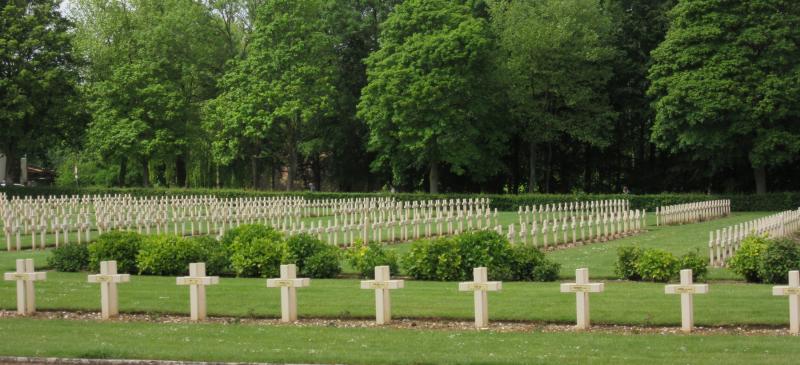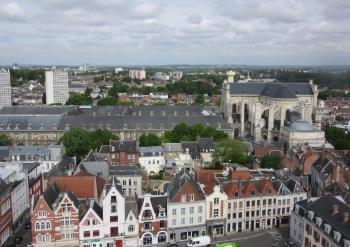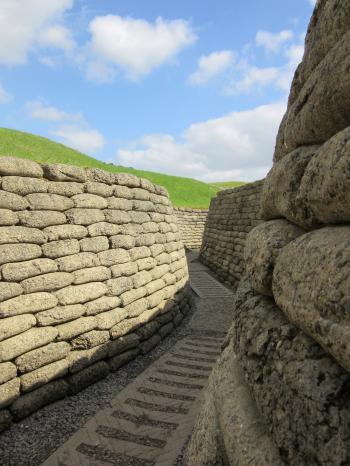Belgium to France: Cruising the Canal du Nord
This article appears on page 6 of the January 2017 issue.
My husband, Cesar, and I took a 7-day canal cruise in May 2016 with European Waterways along the Canal du Nord, traveling from Bruges, Belgium, down to Amiens, France.
The theme of the cruise was the history of the Commonwealth soldiers who fought in northern France during World War I. While I can’t say that I’m a particular fan of military history, I found this tour fascinating. The variety of places and things scheduled on our itinerary was a good mix and offered some balance to the number of war history sites visited.
Life on board
European Waterways is very flexible in their itineraries, and I was told that the captains try, whenever possible, to include elements that the passengers request. In our case, we were much pampered.
Since this cruise started only weeks after a terrorist bombing in Brussels, there was only one other couple on board our 12-passenger barge. (They were also Americans.) Our original itinerary included visits to many Australian and British memorial sites, but we requested fewer memorial sites, more historic battle location visits and an additional town visit.
Traveling in France during May meant spring weather, with its full range of conditions. We had sunshine and hot days, closely followed by rain showers and cooler weather. Luckily, the rains came mostly at night or while we were traveling by van.
We sailed aboard the Panache, a luxuriously converted canal barge. Cesar and I had previously cruised the Burgundy Canal with European Waterways on L’Impressioniste (Feb. ’14, pg. 6). In comparison, the Panache was a bit wider and seemed more open and airy.
The topside deck was a great place to relax and watch the scenery go by. The main deck, with the salon and dining area, was bright, with windows all around. On the lower deck, all six of the double cabins were designed exactly alike.
Our comfortable cabin had enough room to walk around the bed on both sides, and it was furnished with small nightstands and reading lights, a desk with a TV/DVD player above it and a full-size wardrobe with drawers underneath for our clothes. The bathroom had a double sink and a step-in shower. It was very nice and included plenty of luxury touches, like bottled water and wine provided in the rooms, high-end toiletries and cushy bathrobes.
As on all their barge cruises, all wine and liquor was included in the price. The salon’s bar was open and fully stocked at all times. There were soft drinks and juice available in the mini-fridge as well. Wi-Fi was usually available when we were moored.
The Panache tied up each night, so we slept peacefully, with just the sound of the lapping canal water. It was cool and breezy on our first morning of sailing, but we didn’t mind, sitting out on the deck with our jackets on and sipping hot coffee.
Onboard dining
We started our cruise in Bruges, Belgium, where a European Waterways van picked us up at our hotel on a Sunday afternoon. We were met by our captain, Arno, and were introduced to the five crew members who would be taking care of us and the ship for the week.
The service on board was outstanding. If you go on the first cruise of the season, as we did, you may get one or two trainees on the staff, but, even though on our cruise some of them were “learning the ropes,” it didn’t affect the service.
Our chef, Scotty, provided us with cooked breakfasts, light lunches with salads and yummy entrées and, each night, a full gourmet dinner. At both lunch and dinner, there were always two wines to savor and a cheese course featuring local specialties.
Showing the variety and style of our dining aboard, one dinner included a gazpacho starter, an appetizer of mini-falafels on a bed of mixed spring lettuce and an entrée of salmon, green beans and mashed potatoes with mustard seeds and, for dessert, ginger cream. We also had pre-bedtime treats of apple tarts, tiny brownies or crème caramel. Scotty was an excellent chef!
Ypres
The scenery along the Canal du Nord varied as we followed it through rural areas with orchards, farms and small villages and through more industrial areas of warehouses and storage yards.
Our first excursion was to Ypres and the In Flanders Fields Museum. Upon entering the museum, I was given a bracelet with a microchip that, when held up, activated any of the various interactive exhibits, tracing the personal history of three different participants in the war.
I followed the stories of a 20-year-old British soldier (who was wounded but survived the war), a 16-year-old Canadian nurse (who was killed when a bomb hit the field hospital where she worked) and a Canadian chaplain (who was the first black chaplain to serve in his division). Each person on our tour was “assigned” a different set of people.
In the old city center of Ypres, the huge Cloth Hall, built by merchants for storage and their textile market, stands across the square from the cathedral. That this guild hall is almost as big as the city’s cathedral shows how important the cloth industry was to the city in medieval times.
Although much of Ypres and the surrounding villages were pounded into rubble during World War I, the people of the city spent their own time and money (which were certainly in short supply after the war) to restore their city. The cathedral, guild hall and other historic buildings were completely rebuilt to their original plans.
After dinner at a local restaurant, we walked over to the Last Post ceremony, which has been held nightly (at 8 p.m.) for nearly 90 years! Every evening, the street is blocked off under the Menin Gate Memorial arches, upon which the names of more than 54,000 soldiers killed in the war are engraved. After wreaths are placed by representatives of various civic groups, the “Exhortation” is spoken.
They shall grow not old, as we that are left grow old:
Age shall not weary them, nor the years condemn.
At the going down of the sun and in the morning,
We will remember them.
(Lines taken from the poem “For the Fallen” by Laurence Binyon)
The gathered crowd responded together, “We will remember them,” and, after a minute of silence, the bugles sounded the Last Post.
In a reflective mood, we started back to the boat, making a short stop at what was to be a most memorable location for me.
The Pool of Peace is a beautiful, tiny park that slopes down to a perfectly round pool of water. The crater was created by the detonation of a huge underground cache of munitions during World War I, and it was filled with water after the war to form the pool.
In the twilight, it was very quiet. The birds were singing and settling in for the evening, and the spring weather had brought blooms to the trees around the pool. It was a lovely place, a pointed contrast to the destruction of war.
Honoring sacrifices
The next day, we continued learning about the Western Front of World War I in France when we visited the French National War Cemetery of Notre Dame de Lorette in Ablain-Saint-Nazaire.
At the top of a hill, we parked near a chapel and stepped out into the park-like grounds filled with thousands and thousands and thousands of white crosses. An honor guard of veterans stood watch at the chapel and around the site.
There are many memorial sites scattered throughout the countryside, but it was here that the French created the largest national cemetery for the soldiers who died along the Western Front.
It is the final resting place for the remains of 39,985 soldiers, about half of whom are unidentified, who were killed in WWI. It took years to reclaim the dead from the battlegrounds and rebury them properly with honors.
I was moved to see how important the French felt it was to honor and remember those who died fighting the war. Visiting the graves is not simply a sad ritual, however. These memorials also remind us of how the culture and lives of the French have been able to continue because of the sacrifices made by so many.
Across the road was a more modern memorial, the Ring of Remembrance. Hundreds of large metal panels arranged in a huge circle sit on the edge of a hill. The metal panels are engraved with the names of 579,606 soldiers, including Germans, Russians, French and British, who died in northern France during the war.
I was quickly drawn into reading the names and noticed the hundreds of “Smiths” on panels right next to hundreds of “Schmidts” — so many young men. It’s an amazing memorial and well worth a visit.
Vimy Ridge
Our visit to Vimy Ridge gave us a more regional history. The site is still pockmarked from the continuous mortar shelling of the long WWI battles fought there. There are still areas fenced off because they contain unexploded ordnance…100 years later!
We arrived late in the afternoon at the outdoor Canadian National Vimy Memorial and so toured it on our own. I actually enjoyed being left alone to roam around and see the remains of the trenches where the armies faced each other for months.
I stood at the crest of the hill for an overview of the area where the Germans had been dug in with deep trenches, tunnels and bunkers all around the ridge. In April 1917, after many months of stalemate, Canadian and other Commonwealth troops stormed in. Following several days of fighting, with brutal casualties, they took the ridge and held it.
Our tour the next day was in the nearby city of Arras. We visited on a market day, when the center square of the Old Town was taken over by stalls selling a huge variety of fresh produce, bread, meats, cheese, clothing, electronics, books, jewelry and fabric. We shadowed our ship’s chef, Scotty, for a while as she shopped at the produce stalls, then we went off to climb the town’s belfry.
The belfry offered a great overview of Arras. We took the elevator up most of the way to the top, then climbed a couple of flights of stairs to get to the viewing platform. Looking down at the square, we could see the unique architectural style of Arras, its narrow houses and stores with flat fronts lined up at the curbs.
One of my favorite museums of the trip was in Arras: the Wellington Tunnels. Once a limestone quarry, used since medieval times to provide stone for the cathedrals, huge public buildings and private estates in the area, its tunnels were closed up when the quarry was spent, and, for the most part, the site was forgotten. However, during WWI they were rediscovered and repurposed.
When Arras was being pounded into rubble by attacks, British and New Zealander troops working out ways to protect the townspeople redug the tunnels in the quarry. They realized that they could quietly extend the tunnels almost up to the German lines, and they spent months with hand picks and shovels doing just that. When a major offensive attack was planned, they managed to pack supplies, munitions and 24,000 men underground for five days while they waited for the word to burst out and attack.
Sadly, though the Arras troops were able to gain their offensive goals (at huge loss of life), other areas of the line failed and they ended up losing all the ground gained.
Our guide took us down into those tunnels and, during our walk from one station to another, explained the story. There were excellent displays and interesting artifacts all around. It was worth putting on the silly-looking helmets that were required.
Into the valley
Next we headed into the Péronne region, passing through many stepped locks to get down into the valley.
In Péronne we visited an old fortified château that houses the Historial de la Grande Guerre (Historical Museum of the Great War). The collections were very well presented, each room displaying three “tracks” of exhibits: one from the French perspective, one from the German and one from the British. So, for example, in the uniform room, you can see each type of uniform and contrast their similarities and differences.
At Le Tommy Restaurant & Museum in Pozières, we stopped for a quick drink. This quirky restaurant had a huge collection of WWI artifacts, gathered by its owner. He proudly led us around the tiny backyard where he had created a display showing, on one side, what life was like in the German trenches and, on the other, life for the British. It was odd but quite interesting.
The next day we focused on the Battle of the Somme, visiting two sites: the Beaumont-Hamel Newfoundland Memorial and the Thiepval Memorial to the Missing. Both were lovely locations that were very green and grassy during our spring visit. Again, there was a peaceful and reverent atmosphere.
At Beaumont, we climbed down into the trenches that have been preserved and restored. In contrast, the Thiepval Memorial, a huge, impressive architectural statement, sits at the top of a hill looking out over the battlefields below. The monument is engraved with the names of the more than 72,000 soldiers who were declared missing in the Somme between July 1915 and March 1918.
Amiens
Our final day of touring was in Amiens, a government seat, a college town and a favorite for travelers.
The kings of France and Belgium were a little competitive over who had the best “Little Venice,” so Amiens features a network of little waterways to rival those in Bruges. It was easy to stroll around the city center, with its many sidewalk cafés and bars, but the cobblestones were a bit uneven and my ankles were pretty sore by the end of the day.
Amiens was behind the lines during WWI and, so, suffered little damage in that war, but it was a popular place for R&R. The architecture of the city center spans many centuries, resulting in an eclectic mix of styles.
On our way back to the boat for our last night aboard and the Captain’s Dinner, we made a special side trip. One of our shipmates had expressed an interest in seeing some planes from WWI, and Captain Arno tracked down an aviation club with a collection of restored planes from WWI and WWII.
We were met at the private airport by a member of the club, who opened the hangars and led us around to look at the restored biplanes and Piper Cubs. Arno translated, and the men were soon deep into the arcane details of aviation during the World Wars.
A summary
I was pleased with our excellent, personable captain and crew. Captain Arno often acted as our guide, and he would look out for little treats or unusual things for us to see. When we used local guides for a tour, he would sometimes come with us just to be sure we understood and got the full benefit of the explanations given.
A gasoline strike during our visit caused the crew to have to shuttle us around, as the boat often moved in search of fueling stations while we were out touring, but we found it each time.
I prefer going early in the cruising season because there are fewer crowds, and, though you do have the chance of rain, the cooler weather makes it much easier to enjoy the daily walking tours.
The rains held off till our very last night, but the week after we left, it poured! There was terrible flooding in Paris. We were so lucky to have missed that.
All in all, I loved this canal cruise with European Waterways. The cruise-only price ($5,250 per person, double, in low season to $6,090 per person during high season) includes accommodation and all food, beverages and touring. Pre- and post-cruise hotel stays can be booked at additional cost.
Mary Beltran was a guest of European Waterways (Berkshire, England; phone, in the US, 877/879-8808, www.europeanwaterways.com).





